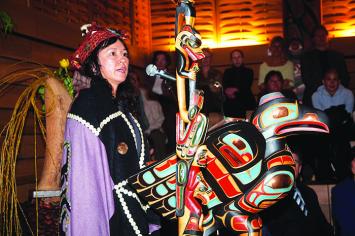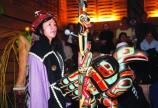Spectacular space embodies relationship with Indigenous communities

The University of Victoria celebrated the official opening of First Peoples House on Jan. 25.The Lieutenant Governor of British Columbia, the Honourable Steven L. Point, and Her Honour Mrs. Gwendolyn Point—the patrons of First Peoples House—joined other guests in songs of honour and celebration inside the packed ceremonial hall.
“With the opening of UVic’s First Peoples House, we fulfill one of our most significant strategic initiatives,” said UVic President David Turpin. “This beautiful structure in the heart of our campus demonstrates our strong commitment to building on and expanding our valued relationship with Indigenous communities. The First Peoples House provides a welcoming and supportive space for the community and an academic and cultural centre for Indigenous students, faculty and staff. It will play an important role in linking UVic with the Indigenous communities in the years ahead.”
The building houses the Office of Indigenous Affairs, Aboriginal student counselling services, classroom space, a student lounge and Elders’ lounge, offices for faculty and the LE,NONET project as well as a ceremonial hall and kitchen. Elders are on site three days a week to provide advice and guidance to students.
“Now that we have this beautiful space, we’re able to provide holistic support to Indigenous students,” said Fran Hunt-Jinnouchi, director of the Office of Indigenous Affairs. “Our programming is rich and full, offering everything from a Good Food Box program to academic and career-related workshops to spiritual support and guidance in ceremony.”
“First Peoples House gives Indigenous students a place to come where they feel like they belong,” said Robina Thomas, co-chair, with Hunt-Jinnouchi, of the First Peoples House Advisory Council. “We’re trying to find a balance between academics—a space where students can learn—and a place where people can learn about First Nations culture and history.”
The advisory council provides guidance and advice on the mission, purposes and priorities of the House and develops principles for the use of this unique campus space.
The council includes representatives appointed by chiefs of local First Nations communities, as well as UVic staff, faculty, graduate and undergraduate students.
An open house for the campus community is planned for March. Details: http://web.uvic.ca/inaf/
Welcome figures showcase family and teaching
By Kerissa Dickie
Greeting visitors from their eastern-facing posts, two distinguished figures stand outside First Peoples House. Carved of old-growth cedar (300–400 years old) from northern Vancouver Island, the posts depict a mother holding a baby, and a father with a young child. The mother holds her free hand up in a traditional gesture of thanks and welcome, her feet dancing, while the father holds a protective arm around his son. The artist, Doug Lafortune from the T’sawout Nation, envisioned these figures to symbolize welcome and to showcase the importance of family and teaching. Doug’s son, Bear, and Doug’s younger brother, Aubrey, helped him carve these figures.
House posts symbolize a new beginning
By Kerissa Dickie
Two beautiful house posts now stand in the front foyer of First Peoples House, framing the thick carved doors to the ceremonial hall with deeply meaningful symbols of rebirth. Three frogs climb upward and downward (respectively) on each, between a sacred cedar rope design at floor and ceiling. Artist Charles Elliott from the T’sartlip Nation and his apprentices worked for three months on this project, using old-growth red cedar trees from the Jordan River area.
His vision for the posts, in their placement at the entrance of the First Peoples House, was to create symbols of a new beginning to honour new, stronger relationships between the University of Victoria and First Nations people. “Three frogs climb upward on one house post signifying a new cycle or new beginning. On the right side three frogs climb downward to show a complete cycle,” Elliott said. “Frogs are in tune with the rhythms of the earth and their singing is a signal to First Nations people of a new year.”
In the flood story of his community, the people received signs of a great flood and used cedar rope tied to the tops of the mountains to anchor themselves to the earth. The oceans rose and flooded the land. As the water finally began to recede and the marooned people awaited signs of life, first the raven and then the frogs appeared. The image of frogs climbing upward, out of the water, was a signal that life was returning and carrying on. It is said that in the highest mountain caves of Saanich, even today, you might find remnants of this ancient rope.
More First Peoples House information, photos and video:
Architecture informed by Coast Salish traditions
The design of First Peoples House, by award-winning Vancouver architect Alfred Waugh, Chipweyan (Fond du lac Band), incorporates suggestions heard during consultations with First Nations leaders as well as Indigenous faculty, staff and students. Following the Coast Salish style, unique features include rammed earth walls, cedar plank exterior cladding and Indigenous carvings and artwork. The ceremonial hall was built in the Coast Salish long-house design, and features woven cedar walls, a gas fire pit and skylights representing smoke holes.
- Architect: Alfred Waugh Architect
- General contractor: Knappett Projects Inc.
- Building size: 1161 square meters (12,500 square feet)
- Project budget: $7 million, with funding from the province of British Columbia ($2.6 million), Bank of Montreal and TD Bank Financial Group, as well as private donations
In harmony with the environment
Designed and built to meet the university’s high standards for energy efficiency and sustainability, First Peoples House is expected to achieve gold-level certification in the Leadership in Energy and Environmental Design (LEED) green building rating system.
Sustainability features include: green roof, stormwater retention pond, natural ventilation, locally sourced materials, connection to a dual plumbing system that allows the use of treated waste water in toilets and urinals, landscaping with native trees and vegetation, including Garry oak and Douglas fir trees. The upper portion of the green roof slopes toward the stormwater retention pond so that rainwater flows down a unique “waterfall” feature into the pond when the roof reaches its absorption capacity.
A place for art
Indigenous carvings and artwork enhance First Peoples House. “A major element in the design of the building was the placement of ceremonial pieces to define the main spaces,” says Martin Segger, director of the University of Victoria Art Collections. “The competition for commissioned artistic works prompted a response from Aboriginal artists throughout the Pacific Northwest. Ultimately artists and works were selected to represent the nations, first of the traditional Coast Salish territory, and then Vancouver Island.”
“The building’s central corridor acts as an exhibition ‘galleria,’ providing a venue for changing presentations drawn from the university’s internationally renowned collection of First Nations limited edition art prints.”


